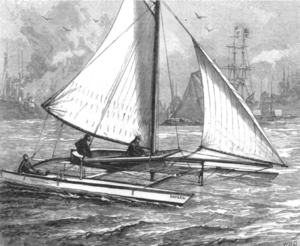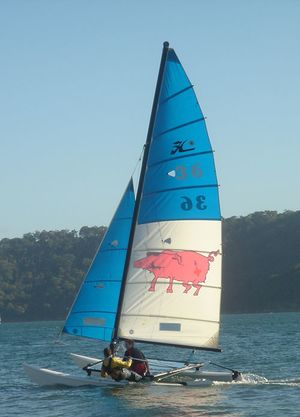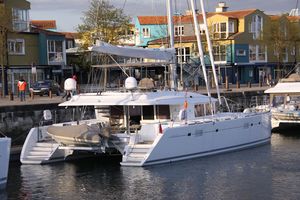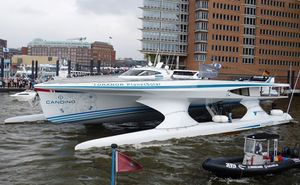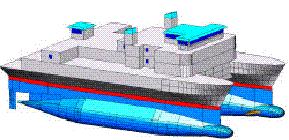قطمران
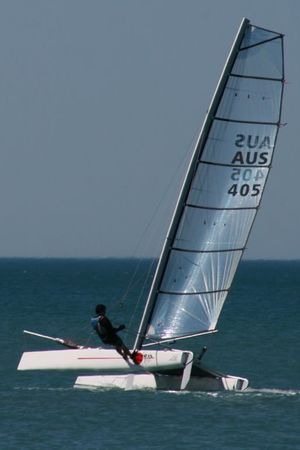
A catamaran (/ˌkætəməˈræn/) (informally, a "cat") is a multi-hulled watercraft featuring two parallel hulls of equal size. It is a geometry-stabilized craft, deriving its stability from its wide beam, rather than from a ballasted keel as with a monohull sailboat. Being ballast-free and therefore lighter than a monohull, catamarans often have a shallower draft (draught) than comparably-sized monohulls. The two hulls combined also often have a smaller hydrodynamic resistance than comparable monohulls, requiring less propulsive power from either sails or motors. The catamaran's wider stance on the water can reduce both heeling and wave-induced motion, as compared with a monohull, and can give reduced wakes.
Catamarans range in size from small (sailing or rowing vessels) to large (naval ships and car ferries). The structure connecting a catamaran's two hulls ranges from a simple frame strung with webbing to support the crew to a bridging superstructure incorporating extensive cabin and/or cargo space.
التاريخ
Catamarans from Polynesia and South Asia became the inspiration for modern catamarans.
Polynesian and Asian catamarans
Performance characteristics
Catamarans have two distinct primary performance characteristics that distinguish them from displacement monohull vessels: lower resistance to passage through the water and greater stability (initial resistance to capsize). Choosing between a monohull and catamaran configuration includes considerations of carrying capacity, speed, and efficiency.
Resistance
At low to moderate speeds, a lightweight catamaran hull experiences resistance to passage through water that is approximately proportional to the square of its speed. A displacement monohull, by comparison experiences resistance that is at least the cube of its speed. This means that a catamaran would require four times the power in order to double its speed, whereas a monohull would require eight times the power to double its speed, starting at a slow speed.[1] For powered catamarans, this implies smaller power plants (although two are typically required). For sailing catamarans, low forward resistance[2] allows the sails to derive power from attached flow,[3] their most efficient mode—analogous to a wing—leading to the use of wingsails in racing craft.[4]
Stability
Catamarans rely primarily on form stability to resist heeling and capsize.[1] Comparison of heeling stability of a rectangular-cross section monohull of beam, B, compared with two catamaran hulls of width B/2, separated by a distance, 2×B, determines that the catamaran has an initial resistance to heeling that is seven times that of the monohull.[5] Compared with a monohull, a cruising catamaran sailboat has a high initial resistance to heeling and capsize.—a fifty-footer requires four times the force to initiate a capsize than an equivalent monohull.[6]
Tradeoffs
One measure of the trade-off between speed and carrying capacity is the displacement Froude number (FnV),[7] compared with calm water transportation efficiency.[8] FnV applies when the waterline length is too speed-dependent to be meaningful. It uses a reference length, the cubic root of the volumetric displacement of the hull, V, where u is the relative flow velocity between the sea and ship, and g is acceleration due to gravity:
Sailing catamarans
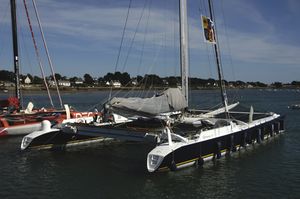
Powered catamarans

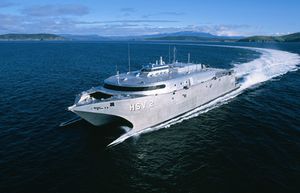
A catamaran configuration fills a niche for powered vessels, where speed and sea-kindliness is favored over bulk capacity. In larger vessels, this niche favors car ferries and military vessels for patrol or operation in the littoral zone. Two advances over the traditional catamaran are the small-waterplane-area twin hull (SWATH) and the wave-piercing configuration—the latter having become a widely favored design.
SWATH
The small-waterplane-area twin hull (SWATH) configuration reduces wave-generating resistance by moving displacement volume below the waterline, using a pair of tubular, submarine-like hulls, connected by pylons to the bridge deck with a narrow waterline cross-section. The submerged hulls are minimally affected by waves.[9] The SWATH form was invented by Canadian Frederick G. Creed, who presented his idea in 1938 and was later awarded a British patent for it in 1946. It was first used in the 1960s and 1970s as an evolution of catamaran design for use as oceanographic research vessels or submarine rescue ships.[10] The SWATH. concept was further developed by Thomas G. Lang, ca. 1968. The US Navy commissioned the construction of a SWATH ship to test the configuration.[11]
SWATH vessels compare with conventional powered catamarans of equivalent size, as follows:[9]
- Larger wetted surface, which causes higher skin friction drag.
- Significant reduction in wave-induced drag, with the configuration of struts and submerged hull structures.
- Lower water plane area significantly reduces pitching and heaving in a seaway.
- No possibility of planing.
- Higher sensitivity to loading, which may bring the bridge structure closer to the water.
Wave-piercing
Wave-piercing catamarans employ a low-buoyancy bow on each hull that is pointed at the water line and rises aft, up to a level, to allow each hull to pierce waves, rather than ride over them. This allows higher speeds through waves than for a conventional catamaran. They are distinguished from SWATH catamarans, in that the buoyant part of the hull is not tubular. The spanning bridge deck may be configured with some of the characteristics of a normal V-hull, which allows it to penetrate the crests of waves.[12]
Wave-piercing catamaran designs have been employed for yachts,[13] passenger ferries,[14] and military vessels,.[15]
References
- ^ أ ب Garrett, Ross (January 1, 1996). The Symmetry of Sailing: The Physics of Sailing for Yachtsmen. Sheridan House, Inc. p. 268.
- ^ Yang, C.; Löhner, R.; Soto, O. (Aug 22, 2001), "Optimization of a wave-cancellation multihull using CFD tools", in Wu, You-Sheng; Zhou, Guo-Jun Zhou, Practical Design of Ships and Other Floating Structures: Eighth International Symposium, Technology & Engineering, 1, China: Elsevier, pp. 1422
- ^ Weltner, Klaus (January 1987), "A comparison of explanations of the aerodynamic lifting force", Am. J. Phys. 55 (1): 52, doi:
- ^ Nielsen, Peter (May 14, 2014). "Have Wingsails Gone Mainstream?". Sail Magazine. Interlink Media. Retrieved 2015-01-24.
- ^ Biran, Adrian; Pulido, Ruben Lopez. Ship Hydrostatics and Stability (2 ed.). Butterworth-Heinemann. p. 414. ISBN 0080982905.
- ^ Howard, Jim; Doane, Charles J. (2000). Handbook of Offshore Cruising: The Dream and Reality of Modern Ocean Cruising. Sheridan House, Inc. p. 468. ISBN 1574090933. Retrieved 2016-01-27.
- ^ Newman, John Nicholas (1977). Marine hydrodynamics. Cambridge, Massachusetts: MIT Press. ISBN 0-262-14026-8., p. 28.
- ^ خطأ استشهاد: وسم
<ref>غير صحيح؛ لا نص تم توفيره للمراجع المسماةWatson - ^ أ ب Misra, Suresh Chandra (2015). Design Principles of Ships and Marine Structures. CRC Press. p. 474. ISBN 1482254476. Retrieved 2016-01-27.
- ^ Helfers, John (2006). The Unauthorized Dan Brown Companion. Kensington Publishing Corp. p. 304. ISBN 0806535806. Retrieved 2016-01-27.
- ^
Editors (1991). Jane's high-speed marine craft (24 ed.). Jane's Information Group. p. 560. ISBN 0710612664. Retrieved 2016-01-27.
{{cite book}}:|last=has generic name (help) - ^ Husick, Charles B. (2009). Chapman Piloting, Seamanship and Small Boat Handling. Sterling Publishing Company, Inc. p. 927. ISBN 9781588167446. Retrieved 2016-01-26.
- ^ Caprio, Dennis (July 2001). "Loomes 83". Yachting. Vol. 190, no. 1. pp. 81–84. ISSN 0043-9940. Retrieved 2016-01-26.
- ^ Yun, Liang; Bliault, Alan (July 8, 2014). High Performance Marine Vessels. Technology & Engineering. Springer Science & Business Media. p. 362. ISBN 978-1-4614-0868-0. Retrieved 2016-01-26.
- ^ Brumley, Jeff (October 5, 2011). "Unusual ship visits Mayport after 6-month deployment to African waters". Florida Times-Union. Jacksonville. Retrieved 2016-01-26.
للاستزادة
- Marchaj, C. A. Aero-Hydrodynamics of Sailing. Tiller Publishing. ISBN 1-888671-18-1.
- Marchaj, C. A. Sail Performance. McGraw Hill. p. 400. ISBN 0-07-141310-3.
- Marchaj, C. A. Seaworthiness:The Forgotten Factor. Tiller Publishing. p. 372. ISBN 1-888671-09-2.


